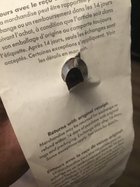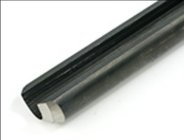-
It's time to cast your vote in the December 2025 Turning Challenge. (click here for details) -
Congratulations to Pat White for "Sicilian Mosaic" being selected as Turning of the Week for December 29, 2025 (click here for details) -
Welcome new registering member. Your username must be your real First and Last name (for example: John Doe). "Screen names" and "handles" are not allowed and your registration will be deleted if you don't use your real name. Also, do not use all caps nor all lower case.
You are using an out of date browser. It may not display this or other websites correctly.
You should upgrade or use an alternative browser.
You should upgrade or use an alternative browser.
Which bowl gouge better to put a 40/40 grind on?
- Thread starter Glenn Lefley
- Start date
- Joined
- Feb 28, 2021
- Messages
- 1,778
- Likes
- 1,592
- Location
- Roulette, PA
- Website
- www.reallyruralwoodworks.com
I believe Stuart Batty uses a parabolic flute on his 40/40 .. also, there is a very similar discussion on these forums from just over a year ago - https://www.aawforum.org/community/threads/budget-gouge-for-40-40-grind.17144/
john lucas
AAW Forum Expert
I have not spoken to Stuart about this so maybe someone who has can answer my question. When I first saw him demon the 40/40 the idea was the wings had a 40 degree sharpened edge as well as the nose. The idea was as you rotate the tool for different cuts using different parts of the edge the cutting angle would always be 40 degrees. Now I see him showing the 40/40 grind using different flute shapes and the wings will have to vary in sharpening angle. For example I have a Henry taylor u shaped gouge and the wings get very acute compared to my Thompson V with the exact same grind. I call my personal grind a 40/45 because the noise is 40 but I swing the handle up.to 45 degrees to give ne a longer wing. The 45 isnt the cutting angle of the edge. Hope you can follow what I just said.
Recently, At the worldwide WoodTurners symposium, Batty demonstrated both the 5/8 oneway master cut M4 parabolic fluted gouge and the Thompson V Fluted shape. I get the sense that he prefers parabolic shape gouges over V flute although he demonstrated how to sharpen both. He stated that the u shaped doesn’t work.
A few years ago, I bought the $28 5/8 cheap Peachtree special to learn how to sharpen on. It worked very well after I learned to sharpen it, except that the handle was way too short for the bowls that I make. I would opt for a 16-22“ handle minimum for bowls.
A few years ago, I bought the $28 5/8 cheap Peachtree special to learn how to sharpen on. It worked very well after I learned to sharpen it, except that the handle was way too short for the bowls that I make. I would opt for a 16-22“ handle minimum for bowls.
Last edited:
To my eye, the gouge pictured on the right would be ok but the left one appears to be a U shaped.
I've been practicing with a Benjamin's Best 5/8" gouge and have become more familiar with using and sharpening a gouge at 40-40 and will be looking to buy one with better metal soon.
I've been practicing with a Benjamin's Best 5/8" gouge and have become more familiar with using and sharpening a gouge at 40-40 and will be looking to buy one with better metal soon.
A gouge flute is hard to photograph, but your second shot looks parabolic to me. The Oneway site was a little obscure on the issue. Perhaps a direct question to CS?I was also thinking on buying a 5/8 bowl gouge to put a 40/40 on, would Oneway gouge work?
https://oneway.ca/products-category/turning-tools-handles/Mastercut Turning Tools
Even if not a true parabola I bet your gouge would work.
The 40/40 gouge grind appears to be another term that lacks dimensional definition regarding the side grind of the wing. I agree with John Lucas re Stuart Batty demo's (at our club) and his definition that the 40 degree bevel needs to extend around the side of the grind. The Michelsen Signature Gouge grind "40/40" appears to come closer to achieving that in my opinion. I have no connection with Johannes Michelson or his company other than using the concept from his video's to make a verson to try for myself.
Ashley Harwood 5/8" V10 40/40 Gouge. What is the side or wing angle? At what point is it measured?
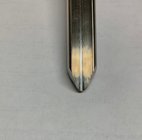
Side front view
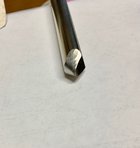
I've only used the gouge for a final cleanup pass on the exterior of 2 bowls using the procedure Stewart demonstrates in his Vimeo Series. I cannot complete a continuous pass w/o losing the cut. The small nose makes it much easier to pick up the cut w/o leaving marks.
Ashley Harwood 5/8" V10 40/40 Gouge. What is the side or wing angle? At what point is it measured?

Side front view

I've only used the gouge for a final cleanup pass on the exterior of 2 bowls using the procedure Stewart demonstrates in his Vimeo Series. I cannot complete a continuous pass w/o losing the cut. The small nose makes it much easier to pick up the cut w/o leaving marks.
I have only a few higher end chisels and use them the most. However I do have three Benjamin's Best 5/8 bowl gouges. I bought a new one recently and the shape of the flute has changed. The first picture is of an older Benjamins Best, second is the new one. I thought they sent me a spindle gouge by mistake, but after checking they do not sell a 5/8 spindle gouge. I was upset until I realized new one may be shaped better to make a Stuart Batty trial gouge, which was my intent when I purchased it. All of my gouges are HSS, planned to upgrade after I get a new sharpening system, what are your thoughts about the shape. Which would make a better Stuart Batty chisel...(on the cheap) 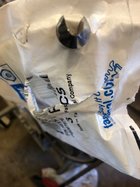
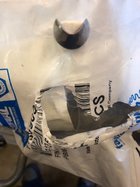


Last edited:
I use the 40/40 a lot. I don't think I have any true parabolic fluted gouges with the 40/40 on them. Most of my bowl gouges are Thompson or D Way. I have a couple of Thompson U flute gouges, and they just are a royal pain to get any kind of a 40/40 on. I usually end up with a wing that is concave. The V shaped flutes work fine for it. Only problem is when you roll the gouge from the wing to the nose, is you slow down too much in the transition area, you can get a birds beak near the nose. It is more of a quick roll. With the parabolic flutes, it is more of a slower roll. I use my U flutes for BOB tools. Most ground to a 60/40 grind or there abouts...
Marvin, your post came up while I was typing mine. Looking at your gouges, both appear to be V fluted, though the one on the right is very open. I think it would be possible to get a 40/40 on either one. Not sure if one would be better than the other. I have a 40/40 on my Lyle Jamieson V flute from Doug, and on my standard V flutes from Doug as well as on my D Way gouges.
robo hippy
Marvin, your post came up while I was typing mine. Looking at your gouges, both appear to be V fluted, though the one on the right is very open. I think it would be possible to get a 40/40 on either one. Not sure if one would be better than the other. I have a 40/40 on my Lyle Jamieson V flute from Doug, and on my standard V flutes from Doug as well as on my D Way gouges.
robo hippy
I'm thinking Benjamins Best has changed suppliers as both of those are bowl gouges with the same LX230 number on them...
I picked up a Thompson 5/8 V gouge for this very purpose. A fellow club member helped me put a 40/40 grind on and it works well. Love it.
I think maybe you forgot how the 40/40 from Stuart suppose to look and work. The 40/40 has a very small bevel, 1/8 in or less. You have the "Kauffman" grind, but not the Stuart Batty 40/40 grind.The 40/40 gouge grind appears to be another term that lacks dimensional definition regarding the side grind of the wing. I agree with John Lucas re Stuart Batty demo's (at our club) and his definition that the 40 degree bevel needs to extend around the side of the grind. The Michelsen Signature Gouge grind "40/40" appears to come closer to achieving that in my opinion. I have no connection with Johannes Michelson or his company other than using the concept from his video's to make a verson to try for myself.
Ashley Harwood 5/8" V10 40/40 Gouge. What is the side or wing angle? At what point is it measured?
View attachment 42987
Side front view
View attachment 42988
I've only used the gouge for a final cleanup pass on the exterior of 2 bowls using the procedure Stewart demonstrates in his Vimeo Series. I cannot complete a continuous pass w/o losing the cut. The small nose makes it much easier to pick up the cut w/o leaving marks.
The Oneway works, Stuart left me a Oneway gouge his first time here.I was also thinking on buying a 5/8 bowl gouge to put a 40/40 on, would Oneway gouge work?
I've about made up my mind that I'm going to purchase a slow speed grinder with at least one CBM wheel and probably an aluminum oxide on the other side. I have been using paper wheels behind 320 grit belts to sharpen knives for years so I turned an old paper wheel down so the top edge will fit inside the flute and it works very well. I'm going to grind both of those Benjamins Best gouges to the Stuart Batty grind and see which works the best for me, then I'll be shopping for a quality gouge that has the flute shape I like the best. Haven't positively made up my mind about the grit of the two wheels nor the shape of the CBN. I'm still trying to figure out which sharpening jig I want, no one seems to be able to get the SB grind down pat with any of the jigs available or I missed something somewhere. I still want to keep the long sweep on my Crown gouge for shear scraping and general turning, it is now my go to gouge most of the time.
Marvin, take the time with one of those BB gouges and do it freehand. It may cost you a 1/4 to 1/2" of the gouge, but you will establish muscle memory that is more than worth it. There are a couple good videos out there, and it is not *that* tricky to master.
I've already got one close freehand, close enough, I'd like to finish it with better wheels and those aren't that far away...thanks
Emiliano, can you expand that explanation some? I am guessing it is the difference between the whole bevel/Kauffman grind and the Batty grind where he grinds off most of the heel of the bevel.
robo hippy
robo hippy
The Ashley Harwood 40/40 ground gouge has not touched the Kaufman grinder. My point is that the term 40/40 grind is used as like it has a definite specification or meaning. Stewart has a 40/40 and Ashley has a 40/40 and the grinds do not appear to be close. I believe they have previously worked together.I think maybe you forgot how the 40/40 from Stuart suppose to look and work. The 40/40 has a very small bevel, 1/8 in or less. You have the "Kauffman" grind, but not the Stuart Batty 40/40 grind.
The term "parabolic flute" seems to be used likewise. I know, a catchy name or phrase sells.
I don't want to derail the thread but a related question: has anyone here used the Ashley HW 3/4" bottom bowl gouge?
I ask I need a larger bottom feeder gouge and have yet to find clear info or pictures on some sites. Thompson doesn't pictures theirs. I have a 1/2 BOB from D-Way that just isn't up to the task on larger pieces.
I emailed Ashley to see if they'd be releasing a 10V version of their bottom feeder and she replied no, with the sentiment being it was unnecessary due to the tool being used only for the bottom of bowls, which does make some sense.
Still, this is a tool I only want to buy once...
I ask I need a larger bottom feeder gouge and have yet to find clear info or pictures on some sites. Thompson doesn't pictures theirs. I have a 1/2 BOB from D-Way that just isn't up to the task on larger pieces.
I emailed Ashley to see if they'd be releasing a 10V version of their bottom feeder and she replied no, with the sentiment being it was unnecessary due to the tool being used only for the bottom of bowls, which does make some sense.
Still, this is a tool I only want to buy once...
i would not take the advice that it is not needed. They don’t make as much money on the better quality of steel. A 10v is a lot less trips to the grinder and holds edge much better. just ask Cindy Drozda, etc, why they use 10v.I don't want to derail the thread but a related question: has anyone here used the Ashley HW 3/4" bottom bowl gouge?
I ask I need a larger bottom feeder gouge and have yet to find clear info or pictures on some sites. Thompson doesn't pictures theirs. I have a 1/2 BOB from D-Way that just isn't up to the task on larger pieces.
I emailed Ashley to see if they'd be releasing a 10V version of their bottom feeder and she replied no, with the sentiment being it was unnecessary due to the tool being used only for the bottom of bowls, which does make some sense.
Still, this is a tool I only want to buy once...
This was my thinking too. Is the Thompson worth getting? I just hate not being able to see it first! Is it the thick-fluted type or just a 3/4 bowl gouge w/ a steeper grind?i would not take the advice that it is not needed. They don’t make as much money on the better quality of steel. A 10v is a lot less trips to the grinder and holds edge much better. just ask Cindy Drozda, etc, why they use 10v.
Hey Allen,I don't want to derail the thread but a related question: has anyone here used the Ashley HW 3/4" bottom bowl gouge?
I ask I need a larger bottom feeder gouge and have yet to find clear info or pictures on some sites. Thompson doesn't pictures theirs. I have a 1/2 BOB from D-Way that just isn't up to the task on larger pieces.
I emailed Ashley to see if they'd be releasing a 10V version of their bottom feeder and she replied no, with the sentiment being it was unnecessary due to the tool being used only for the bottom of bowls, which does make some sense.
Still, this is a tool I only want to buy once...
I have both the Thompson and Ashley Harwood's bottom bowl gouges and I have to say, I think Ashley's is a better design. No, it isn't 10v steel like the Thompson but, everything else about it makes up for the lack of the steel.
First off, it is LONG but, the flute is relatively short, especially compared to the Thompson gouge. Which, you might think that is a downside because you have less gouge available for sharpening. But, because the flute is shorter, and also shallower, you don't get the vibration that you sometimes get with the Thompson gouge. Stuart Batty did a demo that is on YT (long before Ashley developed her gouge) and said that the Thompson bottom gouge is perfect except for the fact that the flute is too long.
If you're going to get one, my ultimate suggestion would be to get the Ashley Harwood gouge!
I actually used it for the first time in my latest video that I posted today.
SB
Thanks Seth!Hey Allen,
I have both the Thompson and Ashley Harwood's bottom bowl gouges and I have to say, I think Ashley's is a better design. No, it isn't 10v steel like the Thompson but, everything else about it makes up for the lack of the steel.
First off, it is LONG but, the flute is relatively short, especially compared to the Thompson gouge. Which, you might think that is a downside because you have less gouge available for sharpening. But, because the flute is shorter, and also shallower, you don't get the vibration that you sometimes get with the Thompson gouge. Stuart Batty did a demo that is on YT (long before Ashley developed her gouge) and said that the Thompson bottom gouge is perfect except for the fact that the flute is too long.
If you're going to get one, my ultimate suggestion would be to get the Ashley Harwood gouge!
I actually used it for the first time in my latest video that I posted today.
View: https://youtu.be/4H2j8WFcx6M
SB
Hey Allen,
I have both the Thompson and Ashley Harwood's bottom bowl gouges and I have to say, I think Ashley's is a better design. No, it isn't 10v steel like the Thompson but, everything else about it makes up for the lack of the steel.
First off, it is LONG but, the flute is relatively short, especially compared to the Thompson gouge. Which, you might think that is a downside because you have less gouge available for sharpening. But, because the flute is shorter, and also shallower, you don't get the vibration that you sometimes get with the Thompson gouge. Stuart Batty did a demo that is on YT (long before Ashley developed her gouge) and said that the Thompson bottom gouge is perfect except for the fact that the flute is too long.
If you're going to get one, my ultimate suggestion would be to get the Ashley Harwood gouge!
I actually used it for the first time in my latest video that I posted today.
View: https://youtu.be/4H2j8WFcx6M
SB
Back to the original thread topic, I am not an expert on the 40/40 grind by any means. But, I have studied it extensively and it is the grind that I use 90% of the time, and here is what I've found...
The only gouges capable of putting a true 40/40 grind on them are those with a parabolic flute, or a Thompson V gouge. The parabolic flute is more than just a marketing term. It is a specific flute shape that differs from the Thompson V gouge in that the inner walls of the flute are not straight; they have a slight curve to them.
The biggest difference in sharpening the two flute styles are the hand movements that are required to achieve the straight 40deg taper on the wings are different. From what I've seen, Stuart recommends the parabolic flute, especially for beginners because it is much easier to learn to sharpen; in contrast with the Thompson V gouge because it's a little harder to master without ending up with the birds beak divots right behind the nose.
That said, all of my gouges are Thompson, with the exception of Ashley Harwood's bottom gouge, and once you learn those hand movements, it's a piece of cake.
I have an entire playlist of videos that I've gathered and personally found to be the most helpful on the 40/40 grind.
The last video in that playlist is, in my opinion, probably the most informative as a whole but, they are all excellent! Here's a link to the playlist if you think you'd find it helpful. https://youtube.com/playlist?list=PL0KIXkTcebc6fDymZz7gtzPWImmmucYhd
Just my half nickel....
SB
Last edited:
Is the longer handle an essential part in using the 40/40grind? do you get more control, or does it tame down the aggressive grind?Back to the original thread topic, I am not an expert on the 40/40 grind by any means. But, I have studied it extensively and it is the grind that I use 90% of the time, and here is what I've found...
The only gouges capable of putting a true 40/40 grind on them are those with a parabolic flute, or a Thompson V gouge. The parabolic flute is more than just a marketing term. It is a specific flute shape that differs from the Thompson V gouge in that the inner walls of the flute are not straight; they have a slight curve to them.
The biggest difference in sharpening the two flute styles are the hand movements that are required to achieve the straight 40deg taper on the wings are different. From what I've seen, Stuart recommends the parabolic flute, especially for beginners because it is much easier to learn to sharpen; in contrast with the Thompson V gouge because it's a little harder to master without ending up with the birds beak divots right behind the nose.
That said, all of my gouges are Thompson, with the exception of Ashley Harwood's bottom gouge, and once you learn those hand movements, it's a piece of cake.
I have an entire playlist of videos that I've gathered and personally found to be the most helpful on the 40/40 grind.
The last video in that playlist is, in my opinion, probably the most informative as a whole but, they are all excellent! Here's a link to the playlist if you think you'd find it helpful. https://youtube.com/playlist?list=PL0KIXkTcebc6fDymZz7gtzPWImmmucYhd
Just my half nickel....
SB
and how long of handle would you use? I’ve got a few Oneway gouges coming.
Hi Glenn!Is the longer handle an essential part in using the 40/40grind? do you get more control, or does it tame down the aggressive grind?
and how long of handle would you use? I’ve got a few Oneway gouges coming.
Personally, I don’t think that the 40/40 grind requires a handle any longer than you would want for any other gouge. The 40/40 can be used aggressively if you want to but, it is also capable of great finesse. Really, it all comes down to the diameter and shape of the piece, along with how much gouge you have overhanging the tool rest.
Last year, I invested in Stuart Batty’s bolster and handle setup, which allows me to use any of his handles with ANY gouge that I have a bolster on. So, I can change my 3/4” 40/40 gouge to use anything from my 36” handle, to my 6” handle, or even no handle at all.
For example, last year I did several production runs of spinning tops for a client. Because the 40/40 is so adept at spindle work, and because the pieces were such small diameter, I ended up using my 5/8 40/40 gouge and just holding on to the bolster on the end, rather than use a handle at all.
That said, I have always preferred longer handles and before I converted to the Stuart Batty handles, I always used a 20” handle for both my 5/8 and 3/4” 40/40 gouges. But, keep in mind that the 40/40 is hand sharpened and requires a wide swing on a grinder platform. So, if you permanently mount a handle, that handle can get in the way. It can absolutely be done, it just presents a few more challenges.
However, when using the bottom bowl gouge, that’s a different story. Length and leverage is the name of the game because you typically have more toolrest overhang with the bottom gouge, than with a bowl gouge.
Just my half nickel…
SB
Last edited:
- Joined
- Apr 27, 2004
- Messages
- 9,308
- Likes
- 6,080
- Location
- Lakeland, Florida
- Website
- www.hockenberywoodturning.com
I like a handle on my bowl gouges long enough so that I can hold it against my hip to shape curves and to do the “A” frame cut in initial roughing. I shift the handle up and down my side as needed.Is the longer handle an essential part in using the 40/40grind? do you get more control, or does it tame down the aggressive grind?
and how long of handle would you use? I’ve got a few Oneway gouges coming.
I don’t need it for leverage or to fight off catches.
If the tool is in cutting position a finger tip grip and body motion controls the cut.
Okay. Sort of makes sense. I just see photos of Stuart making cuts and he has his arm on the end of a three foot handle and his stanch and approach looks like he is holding on for dear life. And the big swing he does using only his right arm. Without ever tucking his arm beside his waist,I like a handle on my bowl gouges long enough so that I can hold it against my hip to shape curves and to do the “A” frame cut in initial roughing. I shift the handle up and down my side as needed.
I don’t need it for leverage or to fight off catches.
If the tool is in cutting position a finger tip grip and body motion controls the cut.
. He seems to drive the cut with his outstretched arm.
Okay. Sort of makes sense. I just see photos of Stuart making cuts and he has his arm on the end of a three foot handle and his stanch and approach looks like he is holding on for dear life. And the big swing he does using only his right arm. Without ever tucking his arm beside his waist,
. He seems to drive the cut with his outstretched arm.
Stuart has a vastly different style than Al does. Using push cuts with a 40-40 is different than turning using a fingernail gouge. Both are worth trying. Also, be sure you are comparing the same type of cut, hollowing the inside of a bowl, there is no way to have the gouge on your hip. Stuart is pretty close to the hip when rounding the blank though.
Well said!Stuart has a vastly different style than Al does. Using push cuts with a 40-40 is different than turning using a fingernail gouge. Both are worth trying. Also, be sure you are comparing the same type of cut, hollowing the inside of a bowl, there is no way to have the gouge on your hip. Stuart is pretty close to the hip when rounding the blank though.
SB
- Joined
- Apr 27, 2004
- Messages
- 9,308
- Likes
- 6,080
- Location
- Lakeland, Florida
- Website
- www.hockenberywoodturning.com
Okay. Sort of makes sense. I just see photos of Stuart making cuts and he has his arm on the end of a three foot handle and his stanch and approach looks like he is holding on for dear life. And the big swing he does using only his right arm. Without ever tucking his arm beside his waist,
. He seems to drive the cut with his outstretched arm.
He is not driving so much as following and maintaining level.
Stewart keeps the tool parallel to the floor and has little tool contact with his body.
He sort of locks his elbow at 90 degrees and follows the cut around.
The 40/40 forces him to have the tool handle across the lathe bed when he cuts near the bottom of the bowl much like starting with the handle across the bed when hollowing a bowl. Stewart keeps his back straight. He does not lean over to make body contact with the tool. When he gets near the rim he has the tool in contact with his body since he can do so with his erect posture.
This short video of Stewart completing a finishing cut should answer questions as to how much force he applies to the tool.
View: https://vimeo.com/68642333
I found that all the videos in his series are worthwhile viewing.
I found that all the videos in his series are worthwhile viewing.
This short video of Stewart completing a finishing cut should answer questions as to how much force he applies to the tool.
View: https://vimeo.com/68642333
I found that all the videos in his series are worthwhile viewing.
Indeed!
SB
Well, Stuart's methods come from turning bowls on a long bed lathe. My first real lathe was a 3520A, and I had turned on it a couple of years before I took a 3 day work shop with both Stuart and Allen Batty. I always slide the headstock down to the end for turning bowls, which is the reason for there being sliding headstocks and pivoting headstocks. This allows me to hold my arms in by my body. I also hold my tools more level when turning both inside and outside of the bowl. Since Stuart turns long bed style, he has to hold his arms out away from his body, which to me is a better alternative to leaning over the lathe bed, and easier on the back. Down side is needing longer handles. My 5/8 inch gouges have 15 or so inch handles on them, and I don't need more, even when hogging out using the Big Ugly tool.
As for BOB tools, I have a bunch. I do not like a square grind on the flute, and prefer a very slight sweep, maybe close to 40 degrees or ) shape. If I leave steps in the bottom of the bowl, that corner likes to dig in. I do prefer to use the BOB tools rolled over on the side rather than flutes vertical. Mostly, I think this gives me a higher shear/slice angle on the cutting edge.
robo hippy
As for BOB tools, I have a bunch. I do not like a square grind on the flute, and prefer a very slight sweep, maybe close to 40 degrees or ) shape. If I leave steps in the bottom of the bowl, that corner likes to dig in. I do prefer to use the BOB tools rolled over on the side rather than flutes vertical. Mostly, I think this gives me a higher shear/slice angle on the cutting edge.
robo hippy
I use the oneway mastercut gouges in a few sizes -5/8 and 1/2 inch, each with a 40-40 grind and love them. They are parabolic flutes. My only nit is the top edge of the flute. It’s a bit on the sharp side. A small nit. I use them for 90% of my work.
I use 18 or 20 inch handles, the 20 inch being a heavier steel handle for the stability.
I use 18 or 20 inch handles, the 20 inch being a heavier steel handle for the stability.


